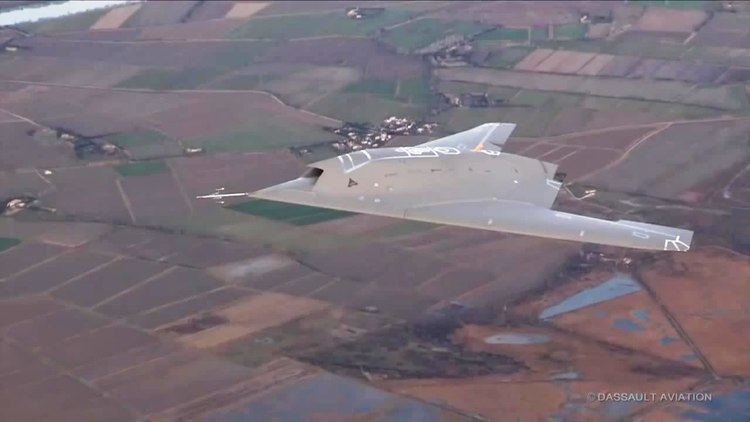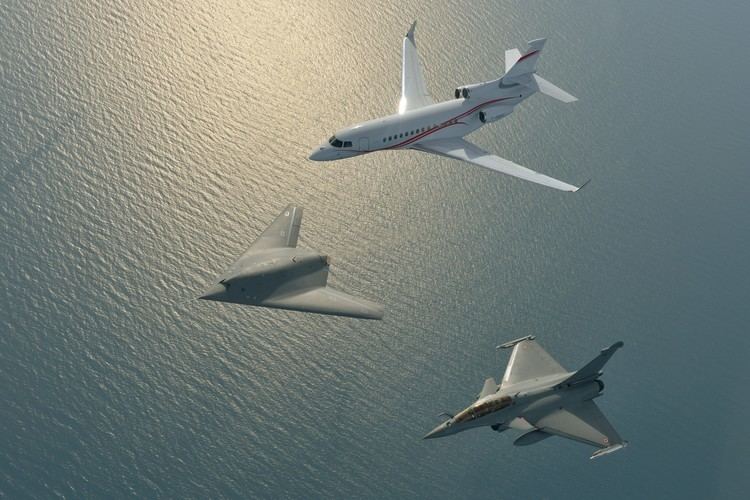Top speed 980 km/h Length 9.5 m Engine type Turbofan | Wingspan 12 m Weight 4,900 kg | |
 | ||
Unit cost 25,000,000–25,000,000 EUR (2013) | ||
The Dassault nEUROn is an experimental unmanned combat aerial vehicle (UCAV) being developed with international cooperation, led by the French company Dassault Aviation. Countries involved in this project include France, Greece, Italy, Spain, Sweden and Switzerland. The design goal is to create a stealthy, autonomous UAV that can function in medium- to high-threat combat zones. Comparable projects include the British BAE Systems Taranis, American Boeing X-45 and Northrop Grumman X-47B, the Indian DRDO AURA, and the Russian MiG Skat.
Contents
- Description
- Program goals
- Platform
- Project history
- Flight testing
- Funding
- Potential French British follow on
- Specifications
- References
The industrial goal is to give European firms experience designing and building high-end UAVs and associated technologies, in order to keep them competitive in the global marketplace. The first flight took place on December 1, 2012.

Description

This flying wing stealth UCAV project is the final phase of the French Dassault LOGIDUC 3-step stealth "combat drone" programme. Until June 2005 it had the form of the original Dassault developed Grand Duc vehicle: supersonic two-engined long-range unmanned bomber, capable of performing attacks with nuclear weapons.

Under pressure of the international cooperation, especially from Sweden and Saab, it was transformed into a demonstrator of smaller single-engine technology. Thus it is now optimised for the testing of various technologies for the future UAVs and UCAVs, and will not enter serial production. It will, however, clear the way for a commercial product, which will use the technologies developed thanks to the nEUROn program. The full-scale replica of the current configuration was unveiled at the Paris Air Show 2005.

The nEUROn development, originally planned by Dassault as "AVE Grand Duc", evolved into a European cooperation including Swedish Saab AB, Greek EAB, Swiss RUAG Aerospace, Spanish EADS CASA and Italian Alenia (today Leonardo-Finmeccanica's Aircraft Division), with Dassault as the lead contractor. As a "technology demonstrator", only one vehicle will be produced to explore new operational concepts for a future generation of autonomous stealth fighter aircraft that will be produced beyond 2020. This is advocated by the statement that the industrial partners want to invest more in technology development, rather than manufacturing of the flying hardware and weapons, despite the risk of the loss of the single prototype.

However Dassault plans to primarily use the data collected by the demonstrator to produce derived UCAVs. The French maker states the nEUROn's Adour engine (adapted from the version used in the SEPECAT Jaguar) will be replaced in the production version by a more powerful, specific, engine based on Snecma's M88 from the Dassault Rafale.
According to the DGA, nEUROn test flights were planned in France, Sweden and Italy in early 2010, but were delayed. Its first flight was at the end of 2012. While nEUROn was on display at the Paris Air Show 2013, it did not fly due to reluctance by European civil aviation authorities to allow UAVs to fly out of closed airspace.
Program goals
The program has three stated goals:
- To maintain and develop the skills of the participating European aerospace companies' design offices, which will not see any other new fighter programs before 2030 now that the Rafale, Eurofighter and Gripen projects are all complete or well underway.
- To investigate and validate technologies that will be needed by 2015 to design next-generation combat aircraft.
- To validate an innovative cooperation process by establishing a European industry team responsible for developing next-generation combat aircraft.
Platform
As a UCAV, nEUROn will be significantly larger and more advanced than other well-known UAV systems like the MQ-1 Predator, with ranges, payloads and capabilities that approach those of manned fighter aircraft. Although the project is not yet closely defined, illustrations and statements by the consortium partners indicate that the nEUROn is envisioned as a competitive system with the American J-UCAS program's Boeing X-45C or Northrop-Grumman X-47B.
Indeed, Saab's February 9, 2006 release notes that nEUROn will be a demonstrator measuring 10 m long by 12 m wide and weighing in at 5 tons. This is roughly the size of a Mirage 2000 fighter rotated 90 degrees (as the nEUROn is wider than it is long). The aircraft will have unmanned autonomous air-to-ground attack capabilities with precision guided munitions, relying on an advanced stealth airframe design to penetrate undetected. Another feature being contemplated is the ability to control squad flight in automatic mode from an advanced fighter like the Rafale or JAS 39 Gripen platform, grouping the nEUROns and controlling the group in a manner similar to many combat real-time strategy computer games.
Project history
In 1999, Dassault Aviation launched its LOGIDUC stealth UCAV program, which gave birth to the Dassault AVE-D Petit Duc that flew in July 2000 as the first stealth UAV in Europe, and to the Dassault AVE-C Moyen Duc (2001). Dassault changed the third phase name "Grand Duc" - a full-scale advanced version of the Moyen Duc - to the more European sounding nEUROn, as the French project was joined by European partners to reduce its development cost. Great Britain didn't join because it was already involved with an American similar program, neither Germany who desisted officially because the country was unable to afford the financial participation.
During the 2003 Paris Air Show, French Minister of Defence Mme Michèle Alliot-Marie announced a major agreement signed between the French groups EADS France, Dassault Aviation and Thales. The agreement covered a joint-venture to "realise a new unmanned military technology that covers all future activity in combat and strategic reconnaissance aeronautics" i.e. LOGIDUC's phase three, "Grand Duc".
EADS leads a HALE (High Altitude, Long Endurance) UAV project.
Meanwhile, the French defence procurement agency, DGA, acting as the program executive on behalf of the participating countries, has entrusted development of the first nEUROn UCAV demonstrator to Dassault Aviation and its European partners. Sub-contracts have been made with the French industrial firms Thales and EADS France and also with five European firms, Saab (Sweden), EAB (Greece), Alenia (Italy), RUAG Aerospace (Switzerland) and EADS CASA (Spain).
Chief project manager Thierry Prunier comes from Dassault Aviation, and the deputy project managers are Mats Ohlson of Saab and Ermanno Bertolina of Alenia. There is a single link between the executive agency (DGA) and the prime contractor (Dassault), and it will be up to the executive agency to coordinate with the government agencies of the participating countries. It will be up to the prime contractor, meanwhile, to coordinate the work with the other industries.
After Spain joined the programme in early February 2006 (Belgium could join later), work breakdown among the European industrial partners was planned as follows:
Dassault claims 50% of development and is responsible for the standalone LOGIDUC programme. The nEUROn (2010) will be the third Dassault stealth UAV prototype following the AVE-D Petit Duc (2000) & AVE-C Moyen Duc (2004). The nEUROn project replaces the LOGIDUC final phase AVE Grand Duc.
Thanks to the technologies developed for the UAV prototype Sky-x (2003) Alenia Aeronautica was the first industrial partner and claims a 25% share of the entire programme.
Saab claims 25% of development and is also the coordinator for the other Swedish corporations involved.
Flight testing
The nEUROn made its first flight on December 1, 2012 in France. Flight trials in France to open its flight envelope and evaluate its stealth characteristics were successfully completed in March 2015. These tests were followed by sensor evaluation trials in Italy, which were completed on August 25, 2015. The last leg of flight trials take place in Sweden and will include live fire trials.
In July 2016 extensive stealth and detection tests where conducted with the nEUROn and the Charles de Gaulle carrier group. The nEUROn was to penetrate the aircraft carrier defensive area to test its stealth and the capacity of the carrier group to detect it.
Funding
The contract is valued at €405 million, and allows industry to begin a three-year system definition and design phase with related low-observability studies. This phase will be followed by the development and assembly phase, and by a first flight in 2011. It is planned that the 2-year flight-test program (2010–2012) will entail about 100 sorties, including the launch of a laser-guided bomb tentatively scheduled for 2012. The initial €400 million budget was increased by €5 million in 2006 due to the addition of a modular bomb bay including a designator and a laser-guided bomb.
In February 2006, DGA had announced that France will provide €202.5 million, half of the program's €405 million ($480 million) budget, while the remaining funds will be supplied by the other participating member nations. In December 2005, the Swedish defence ministry reported the national share would be €75 million, of which €66 million would be financed by Saab AB. The cost of Spain's participation to the program is estimated at €35.5 million, spread over the 2007-2012 period.
Derived production UCAV unit cost is estimated by Dassault to be €25 million.
Potential French-British follow-on
In November 2014 a two-year feasibility study was announced by the French and British governments. This could lead to a program combining the experience of the BAE Systems Taranis and nEUROn programs into a Future Combat Air System.
Specifications
Data from
General characteristics
Performance
Armament
